#Dromaius
Text

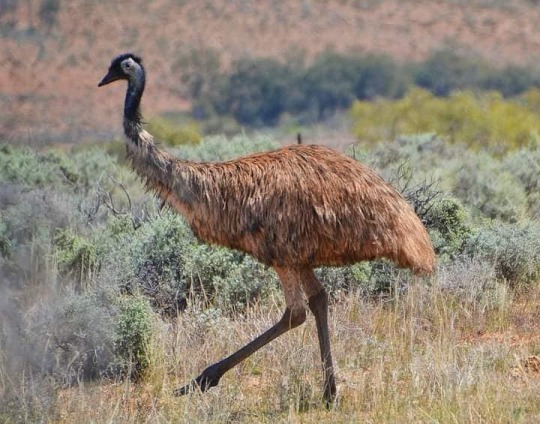
Emu (Dromaius novaehollandiae), family Casuariidae, order Casuariiformes, Flinders Ranges, SA, Australia
photograph by Greg Wisnia
759 notes
·
View notes
Text

photo source
36 notes
·
View notes
Text

Emu, Dromaius novae-hollandiae | Die Vogel (1913) | Alfred Edmund Brehm (1829-1884) | Biodiversity Heritage Library
6 notes
·
View notes
Photo

A new variant has been added!
Emu (Dromaius novaehollandiae)
© GusStar
It hatches from dark, distinctive, endemic, enormous, feathered, few, immature, juvenile, loose, open, ostrich, possible, and shaggy eggs.
squawkoverflow - the ultimate bird collecting game
🥚 hatch ❤️ collect 🤝 connect
13 notes
·
View notes
Text
Sitting Pretty

A comfortable looking emu resting in the heat of the day in the Bird Paradise. Photo credit: Jonathan Chua.
The grass looked a bit overwhelming in the original shot. So the greens and yellows there were toned down in post while the emu had its colours saturated a little bit more.
#photographers on tumblr#bird photography#bird pics#Dromaius novaehollandiae#emu photos#flora fauna#fujifilm hs50exr#fujifilm photography#photography editing
2 notes
·
View notes
Text
BOTD: Emu

Image credit: JJ Harrison
Emu (Dromaius novaehollandiae)
The Emu is the second tallest bird in the world, second to the ostrich. They can sprint up to 30mph (48 km/h) and can cross a whole meter in a single step. They drink infrequently, but take in a lot of water when the opportunity arises. Emus sleep at night but wake up frequently throughout the night to have a snack or relieve themselves - much like humans may do!
#emu#emus#emu bird#dromaius novaehollandiae#tropical birds#birds of australia#australian birds#wildlife#birds#birdlife#bird facts#bird of the day#bird fact of the day#bird-of-the-day#birding#birdwatching
53 notes
·
View notes
Text
Because female birds can lay eggs regardless of whether they are fertilized, however, each partner in a lesbian pair usually contributes a full clutch of eggs to their nest even if she hasn't mated with a male. As a result, female homosexual pairs often lay what are called supernormal clutches, that is, double the number of eggs usually found in nests of heterosexual pairs.¹⁰
10. Supernormal clutches have also been reported for pairs of male Emus, probably because more than one female has laid in their nest. What might be termed "subnormal" clutches – i.e., nests containing fewer eggs than are usually found for heterosexual pairs – are reported for female pairs of Blue Tits. And "super-supernormal" clutches occasionally occur in heterosexual pairs of Roseate Terns: as a result of within-species parasitism and possibly also egg transfer (see chapter 5 for more on these phenomena), some nests containing more than double the number of eggs found even in supernormal clutches (as it also true for "dump" nests in many Ducks and Geese).
"Biological Exuberance: Animal Homosexuality and Natural Diversity" - Bruce Bagemihl
#book quote#biological exuberance#bruce bagemihl#nonfiction#birds#lesbian#eggs#clutch#homosexuality#supernormal#emu#dromaius novaehollandiae#subnormal#blue tit#cyanistes caeruleus#parus caeruleus#roseate tern#sterna dougallii#ducks#geese
3 notes
·
View notes
Text
Such nests contain SUPERNORMAL CLUTCHES of 14-16, and sometimes more than 20, eggs.
"Biological Exuberance: Animal Homosexuality and Natural Diversity" - Bruce Bagemihl
#book quote#biological exuberance#bruce bagemihl#nonfiction#emu#dromaius novaehollandiae#supernormal clutches#eggs#coparenting
0 notes
Text
Ostriches associate in flocks and frequently form sex-segregated groups. (...) Emus generally associate in pairs or groups of 3-10 birds, while Greater Rheas gather in flocks of 15-40 birds outside of the mating season.

"Biological Exuberance: Animal Homosexuality and Natural Diversity" - Bruce Bagemihl
#book quotes#biological exuberance#bruce bagemihl#nonfiction#ostrich#struthio camelus#emu#dromaius novaehollandiae#greater rhea#rhea americana#sex segregation#flock#mating season
1 note
·
View note
Text
Phylum: Chordata
Subphylum: Vertebrata
Class: Aves
Infraorder: Paleognathae
Order: Casuariiformes
Family: Casuariidae
Genus: Dromaius or Casuarius
17 notes
·
View notes
Text
BRACKET A
Superb Lyrebird (Menura novaehollandiae)
These birds are the experts of mimicry. They’ll mimic people talking, chainsaws, kookaburras, toy laser guns, car alarms, cameras, and the females of the species think that’s super hot. They’re one of the world’s largest songbirds. At the Australia zoo, they’re allowed to run around and love talking to and dancing at visitors.
VERSUS
Emu (Dromaius novaehollandiae)
They’re ratites and won a war against the human population of Australia. What more do you want.

50 notes
·
View notes
Text
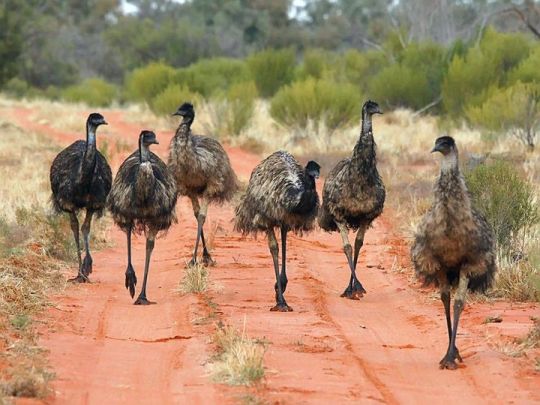
A gang of unruly Emus (Dromaius novaehollandiae), family Casuariidae, central Australia
photograph by David Cook
2K notes
·
View notes
Text

Emu (Dromaius novaehollandiae) feeding through the Flinders Ranges in South Australia!
Credit: Neil Bloem @coldxneil
2 notes
·
View notes
Text
Korkeasaari
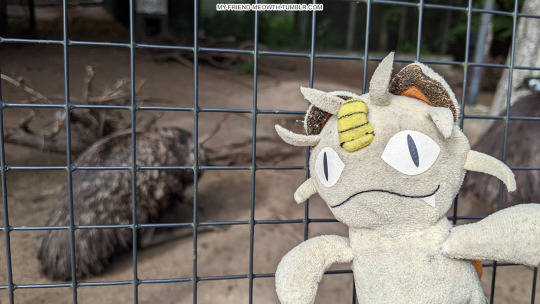


Emu (Dromaius novaehollandiae) Emu

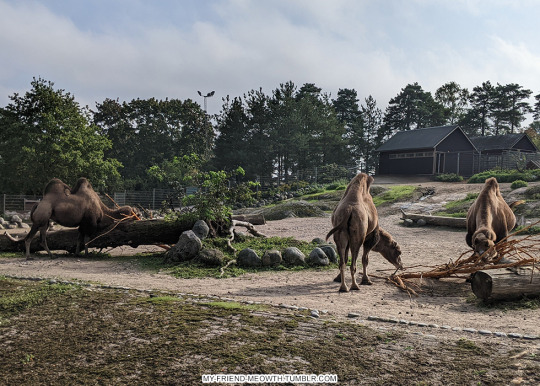
Kaksikyttyräinen kameli (Camelus bactrianus) Bactrian camel
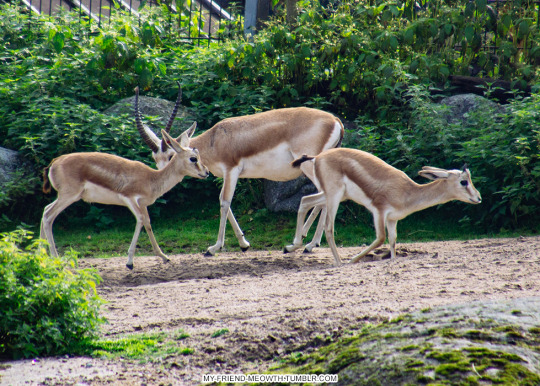
Kuhertajagaselli (Gazella s. subgutturosa) Goitered gazelle

Huulipekari (Tayassu pecari) White-lipped peccary

Pampajänis (Dolichotis patagonum) Patagonian mara
#meowth#korkeasaari#helsinki#emu#bactrian camel#goitered gazelle#white-lipped peccary#patagonian mara#pokemon#my pokemon
18 notes
·
View notes
Text


EMU SKELETON
Dromaius novaehollandiae
1970
The emu is the second-tallest living bird after its ratite relative, the ostrich. It is endemic to Australia, where it is the largest native bird and the only extant member of the genus Dromaius. The emu's range covers most of mainland Australia, but the Tasmanian, Kangaroo Island and King Island subspecies became extinct after the European settlement of Australia in 1788.
Emus were first reported as having been seen by Europeans when explorers visited the western coast of Australia in 1696. This was during an expedition led by Dutch captain Willem de Vlamingh who was searching for survivors of a ship that had gone missing two years earlier. The birds were known on the eastern coast before 1788, when the first Europeans settled there.
Emus are soft-feathered, brown, flightless birds with long necks and legs, and can reach up to 6.2 ft (1.9 m) in height. Emus can travel great distances, and when necessary can sprint at 30 mph (48 kph); they forage for a variety of plants and insects, but have been known to go for weeks without eating. They drink infrequently, but take in copious amounts of water when the opportunity arises.
The skeleton presented here is in very fine to perfect condition, showing no damage and no restorations. It has been mounted on a custom stand.
Koller
14 notes
·
View notes
Photo

Großer Emu (Dromaius novaehollandiae)
28 notes
·
View notes